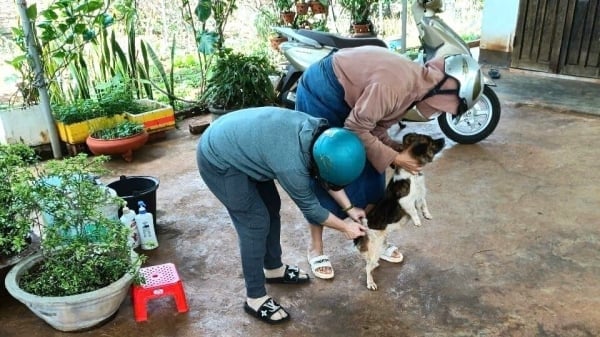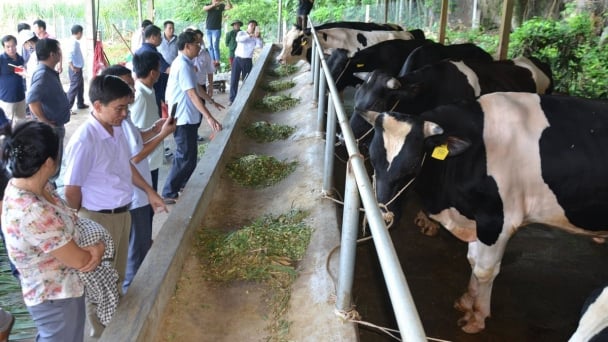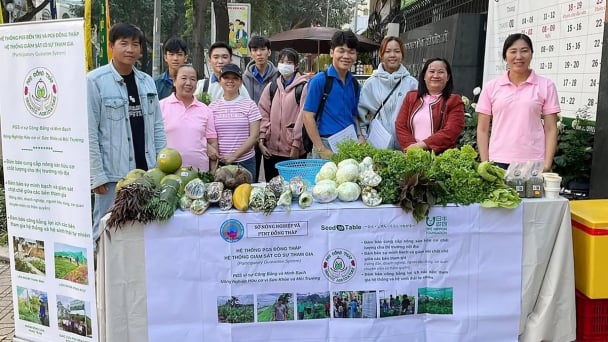May 22, 2025 | 13:07 GMT +7
May 22, 2025 | 13:07 GMT +7
Hotline: 0913.378.918
May 22, 2025 | 13:07 GMT +7
Hotline: 0913.378.918
This is the opinion of Mr. Nguyen Manh Hung, Head of Operation and Irrigation under the Department of Water Resources, in a discussion with the Vietnam Agriculture Newspaper regarding the preparation process for the investment project to construct the Xuan Quan and Long Tuu dams on the Red River.

Mr. Nguyen Manh Hung, Head of Operation and Irrigation under the Department of Water Resources, sharing about the preparation process for the investment project to construct the Xuan Quan and Long Tuu dams on the Red River. Photo: Minh Phuc.
Around three months ago, Deputy Minister of Agriculture and Rural Development Nguyen Hoang Hiep requested the Department of Water Resources to prepare documents, conduct a feasibility study, and expedite the construction of the Xuan Quan and Long Tuu dams on the Red River, with expectations of project commencement by 2026. Could you please provide details on how the preparation process has been coordinated by the Department of Water Resources in collaboration with relevant units up to this point?
The Prime Minister has issued Decision No. 847/QD-TTg on July 14, 2023, approving the Disaster Prevention and Irrigation Planning from 2021 to 2030, with a vision towards 2050. Accordingly, the projects outlined within the plan include Xuan Quan and Long Tuu dams.
The Ministry of Agriculture and Rural Development is currently directing the construction planning for the hydrological basin of the Red River - Thai Binh from 2022 to 2030, with a vision towards 2050. The objective of the planning is to specify solutions for the Xuan Quan and Long Tuu dams within the national planning framework, including tasks, locations, scales, design parameters, water level elevation capacities, and the ability to meet the water requirements of irrigation projects on both sides of the Red River. The plan involves studying and calculating the impacts on the river flow, flood drainage, flood-prone areas, water transportation, environmental and ecological factors. We will continue to assess the investment for the construction project.
For a significant project such as constructing two dam on the Red River, acquiring input and opinions from experts and scientists both domestically and internationally is crucial. This process should be carried out meticulously to obtain a multi-dimensional perspective on the issue before making a final decision. How does the Department of Water Resources plan to undertake this task?
The construction of two dams on the Red River is currently under study as part of the construction planning for the hydrological basin of the Red River - Thai Binh from 2022 to 2030, with a vision towards 2050. In addition to the Xuan Quan and Long Tuu dams, additional dams are being considered.

The bed of the Red River is experiencing significant erosion due to the impact of climate change and sand mining activities. Many pump stations along the river are "suspended," unable to draw water into the system. Photo: Minh Phuc.
During the planning process, the consulting unit (Institute of Water Resources Planning) made proposals for several projects along the main stream of the Red River - Thai Binh and organized a workshop to gather opinions from relevant units within the Ministry of Agriculture and Rural Development and experts in September 2023.
Subsequently, the consulting unit continued to refine the planning documents and prepared a workshop by the end of 2023 to gather opinions from experts, scientists, managers, and local governments within the Red River basin.
According to the anticipated plan for the year 2024, in addition to multiple workshops, the Department of Water Resources will request the Ministry's input to initiate an investment project. This project aims to thoroughly evaluate the feasibility of the main-stream dam construction. The Department will meticulously gather opinions, examining and assessing all impacts—both positive and negative—before proceeding with the implementation.
Considering the current scientific, technological, and engineering capacities within the country, do you think they meet the requirements for investing in the construction of two dams on the Red River? And to construct additional mid-term dams on the Red River from 2026 to 2030, what are the next steps to be implemented?
In terms of scientific, technological, and engineering capacities within the country, we currently possess the necessary conditions to construct dams on the Red River. Accordingly, the Ministry has invested significantly in large-scale river barrages such as Van Phong Dam, Ba Lai Dam, Can Chong Dam, Lang The Dam, Xeo Ro Dam, Thao Long Dam, Bara Do Luong Dam, among others.
Notably, the Ministry of Agriculture and Rural Development has invested in the construction and handed over a saltwater barrier dam, thereby maintaining freshwater and establish a connection between Cai Lon and Cai Be; the Cai Lon culvert consists of 11 culvert chambers and 1 boat lock with a total navigational width of 455 meters. This is currently the largest project in Southeast Asia to be designed and executed by Vietnam.
Furthermore, during the implementation process, we will consult with leading experts in the field of water resources both domestically and internationally, including those from the Netherlands, France, Brazil, etc.
The construction of the dams on the Red River has been approved by the Prime Minister in the Disaster Prevention and Irrigation Planning from 2021 to 2030, with a vision towards 2050.
Regarding the construction of additional mid-term dams on the Red River from 2026 to 2030, the next steps in the implementation process will require strict adherence to the Public Investment Law, Planning Law, Irrigation Law, Dike Law, Water Resources Law, Construction Law, Bidding Law, among many others.
Additionally, it is crucial to pay special attention to the environmental impact assessment of the project. Considerations must be given to its alignment with the socio-economic development plan of the capital city Hanoi, and the waterway and road transportation planning of the provinces. Moreover, we must guarantee the safety of the dykes and flood escape routes.
The Ministry of Agriculture and Rural Development is balancing funding to prepare for the investment phase between 2026 and 2030, with a focus on selecting a consulting firm to conduct a feasibility study for the project. This study will serve as a basis for submitting the investment policy to competent authorities for evaluation and approval.
Thank you!
Translated by Nguyen Hai Long
![Reducing emissions from rice fields: [2] Farmers’ commitment to the soil](https://t.ex-cdn.com/nongnghiepmoitruong.vn/608w/files/news/2025/05/05/dsc08881jpg-nongnghiep-140632.jpg)
(VAN) Clean rice cultivation model in Thuong Tan commune, Bac Tan Uyen district, is assisting local residents in achieving sustainable agriculture by substantially reducing costs, increasing productivity, and protecting the environment.

(VAN) At the conference to disseminate Resolution No. 68, AgriS introduced its digital agricultural ecosystem and reaffirmed its commitment to accompanying the Government in promoting private sector development and sustainable agriculture.

(VAN) 'Blue Ocean - Blue Foods' initiative is designed to restore marine ecosystems and establish sustainable livelihoods for local communities by cultivating a minimum of 1,000 hectares of cottonii seaweed in the first three years.
/2025/05/21/4642-3-112707_603.jpg)
(VAN) The V-SCOPE project has made direct contributions to three out of six pillars of the Comprehensive Strategic Partnership between Vietnam and Australia.

(VAN) Facing the threat of rabies spreading to the community, Gia Lai province urgently carries out measures to vaccinate dogs and cats on a large scale.

(VAN) Disease-free livestock farming not only protects livestock herds but also stabilizes production and livelihoods for many farmers in Tuyen Quang.

(VAN) Japan's grant aid project contributes to capacity building, promoting organic agricultural production, and fostering sustainable community development in Dong Thap province.